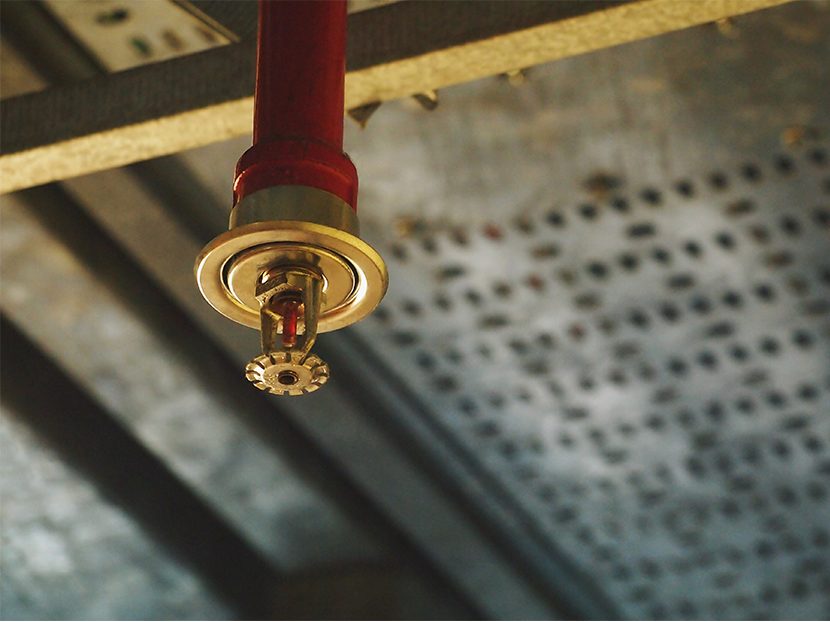Fire Suppression Systems
Recent changes in the International Building Code.

While sitting in on several meetings of the Honolulu AIA Codes Committee, tasked with the review of the 2018 edition of the International Building Code (IBC) for adoption by the Hawaii State Building Code Committee, I noticed several new code provisions that may be of interest to those involved in the design of fire suppression systems. In this column, I will try to highlight some of these changes, including some changes that occurred with the 2015 edition of the IBC.
420.7 Group I-1 assisted living housing units: This new section allows certain living areas, with a requirement for fire resistance rated corridors, to have shared living spaces, group meeting or multipurpose therapeutic spaces open to the corridor under certain provisions. This is to create a more home-like environment for residents. One of the conditions is that there be quick response sprinklers provided.
Similar provisions were included in 407.2.5 in the 2015 edition for Group I-2 Condition 1 Nursing Homes.
Section 428 Higher Education Laboratories: A new use group, defined as:
Laboratories in Group B occupancies used for educational purposes above the 12lh grade. Storage, use and handling of chemicals in such laboratories shall be limited to purposes related to testing, analysis, teaching, research or developmental activities on a nonproduction basis.
Section 428 contains numerous requirements including a requirement for the building to be provided with a NFPA 13 sprinkler system.
503.1.4 Occupied roofs: The 2015 IBC introduced provisions permitting occupied roofs. For roofs with an A-2 occupancy exceeding 100 or any Assembly occupancy exceeding 300, IBC (2015) Section 903.2.1.6 requires all floors between the occupied roof and the level of exit discharge must have a sprinkler system. IBC (2018) Section 503.1.4 seems to trump the provisions by allowing occupied roofs as long as the entire building is provided with sprinklers and the occupied roof is provided with occupant notification from a fire alarm system.
507.4 Sprinklered, one-story buildings: A clarification of the exception exempting sprinklers from:
.. areas occupied for indoor participant sports, such as tennis, skating, swimming and equestrian activities in Group A-4 occupancies
Ancillary spaces (storage, concession booths, press rooms) to the sports activity area are to be sprinklered.
Table 601 (IBC 2015), Footnote d One-Hour Substitution: Footnote d to Table 601 has been deleted, and with this deletion the longstanding fire resistive substitution has been deleted. One can no longer use sprinkler protection, if not already required by the IBC and not used for area or height increase, to reduce the fire resistance ratings of certain building elements by one hour.
603.1 (IBC 2015) Allowable materials: New item in the list of combustible materials permitted in Type I or Type II “noncombustible” construction.
26. Wall construction of freezers and coolers of less than 1,000 square feet (92.9 m 2), in size, lined on both sides with noncombustible materials and the building is protected throughout with an automatic sprinkler system in accordance with Section 903.3.1.1.
901.6.2 Integrated testing: Where two or more “fire protection or life safety systems” are interconnected integrated testing shall be performed in accordance with NFPA 4 Standard for Integrated Fire Protection and Life Safety System Testing. This requirement will be applied to high rise buildings and to smoke control systems where the fire alarm system is integrated with the smoke control system. What is interesting is not only must this integrated testing occur prior to CO, it must also be conducted at minimum 10-year intervals.
902.1 Pump and riser room size: This first came into the 2012 IBC. The 2018 edition has been expanded to include requirements for access, access door marking, environmental control, and lighting.
903.2.1 Group A: Changes to this section clarify where sprinklers are required when Group A assembly occupancies are located in multiple story buildings.
903.2.1.6 (IBC 2015) Assembly Occupancies on Roofs: New section permitting an “occupied roof,” for certain assembly occupancies provided all floors between the occupied roof and the level of exit discharge are sprinklered.
903.2.1.7 (IBC 2015) Multiple Fire Areas: New section that is basically a clarification of what was intended. Where a fire area has multiple assembly occupancies with less than 300 persons in each separate assembly, but the combined total of the assemblies is 300 or more, sprinklers will be required.
903.2.3 Group E: Additional thresholds for sprinklers have been included. Sprinklers are required for any Group E Education occupancy with a fire area located on a floor other than the level of exit discharge. There is an exception to this sprinkler requirement. Also, sprinklers are required for any Group E Education occupancy with a fire area that has an occupant load of 300 or more.
903.2.8 (IBC 2015) Group R: The level of sprinkler protection for Group R-4, for example residential board and care facilities, will depend on occupant evacuation capability. For R-4 where occupants can evacuate without assistance (Condition 1) a NFPA 13D system is required. Where occupants require at least some verbal or physical assistance (Condition 2) a NFPA 13R system is required and additional protection is required for attics of combustible construction.
903.3.1.1.2 Bathrooms: In the 2015 edition, sprinklers were permitted to be omitted from bathrooms within dwelling units of residential occupancies, except for Group R-4 occupancies. The 2018 edition has been revised to extend the permission to omit sprinklers in R-4 bathrooms also.
903.3.1.2.1 Balconies and decks: Adds a provision permitting balconies and decks to be constructed without a fire resistance ratings in Buildings of Type III IV, and V construction when sprinkler protection is extended to cover the balcony or deck (see Section 705.2.3.1 Exception 3).
903.3.1.2.2 (2015) Open-Ended Corridors: Another clarification. In buildings that have interior corridors but are open-ended, i.e., there are exterior stairs at the end, the corridor and the egress through the stairs must be sprinklered.
903.3.1.2.3 Attics: This is truly a significant change, intended to address the problems with fires in residential occupancies protected with NFPA 13R systems. This new section contains a series of provisions for requiring sprinkler protection or other measures.
903.3.8 (IBC 2015) Limited Area Sprinkler Systems: New tougher limits on the use of these systems. Now limited to six sprinklers instead of twenty, Light Hazard or ordinary Hazard Group 1 areas only, control valves that are supervised or locked open, and hydraulic calculations.
904.12 Commercial cooking systems: This section, which was added in the 2015 edition, has been revised by adding a reference to NFPA 96. Also, water mist has been added to the available list of suppression options for protection of commercial cooking equipment and exhaust hoods.
904.13 Domestic cooking systems: This section, intended to address group cooking in institutional areas, has been expanded to include Group I-2 Condition 1 occupancies and Group R-2 college dormitories in addition to Group I-1 condition 1 occupancies. Hoods over cooktops must be protected by a fire suppression system and cooktops and ranges must be equipped with listed ignition resistant burners (refer to UL 858).
904.14 Aerosol Fire-extinguishing Systems: Recognizes these systems as alternative suppression systems and requires compliance with NFPA 2010.
Standpipe Systems 905.3.1 Height: In addition to the height thresholds, standpipes are required when there are four or more stories above or below the grade plane.
905.4.1 Location of Class I standpipe hose connections: The location of hose connections changed from intermediate landing of stairs to main landing (will it never end?). Also, an exception permitting a single hose connection in open breezeways or open corridors when stairs are not greater than 75 feet apart.
Section 910 (IBC 2015) Smoke and Heat Removal: Some complicated changes which have some bearing on sprinkler requirements. Please check it out yourself.
1009.7 Exterior areas for assisted rescue: There is an exception to the separation requirements of 1009.7.2 when the building is sprinklered.
1010.1.9.8 Delayed egress: The list of occupancies which can use delayed egress devices has been expanded. Of course, as has always been the case, delayed egress cannot be used unless the building has a sprinkler system or an automatic detection system.
1010.3.2 Security access turnstiles: Permitted to be a component in the means of egress when meeting a slew of requirements one of which is that the building is provided with sprinkler protection.
1017.2.2 (IBC 2015) Groups F-1 and S-1 Increase: Travel distances for these occupancies have been increased to 400 feet in one story buildings, with minimum ceiling/roof height of 24 feet and with automatic sprinklers.
Now for the usual disclaimers. Please do not go running off and change anything until you have confirmed that what I have presented is what the applicable code actually intends. Also, some jurisdictions make their own amendments and may not accept some of the new changes.
SFPE Notes:
The SFPE Subcommittee on Research & Innovation recently unveiled SFPE’s roadmap, which identifies the future research needs for the fire safety engineering profession. This roadmap is intended to be a living document and have a long-term focus that will be central to defining the future of SFPEs technical initiatives. The roadmap also will form the basis of how SFPE will a) coordinate research initiatives for the profession, b) form partnerships with research providers and c) form subthemes for future SFPE conferences. Be sure to go to the SFPE website to review and comment on the roadmap. Provide comments to engineering@sfpe.org.





